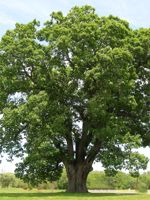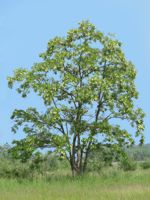Mon-Fri 9am - 5pm Mountain time
White Oak vs Black Locust
Quercus alba
Robinia pseudoacacia
White Oak is large, long-lived tree with an irregular trunk divided into spreading, often horizontal, stout branches. A highly adaptable tree, White Oak features green acorns and beautiful green leaves that turn red-purple in the fall.
With a huge growth in bourbon and scotch over the past few decades there is an emerging shortage of white oak that is the primary tree used for cask barrels and aging.
Note: Most Oak species can be considered toxic for many animals.
Black Locust is an attractive tree. Its distinctive leaves are made of about a dozen bright green leaflets. It also notable for its fragrant white flowers, which smell of citrus.
Black Locust can grow in many situations, but prefers dry areas with lots of sun. It is robust and is an excellent choice for establishing shade in dry, open areas.
Important note: Much of the Black Locust is toxic to humans and livestock, including seeds, bark, and leaves.

